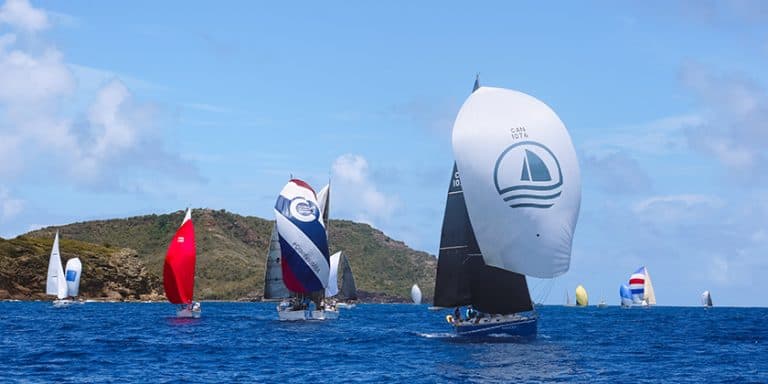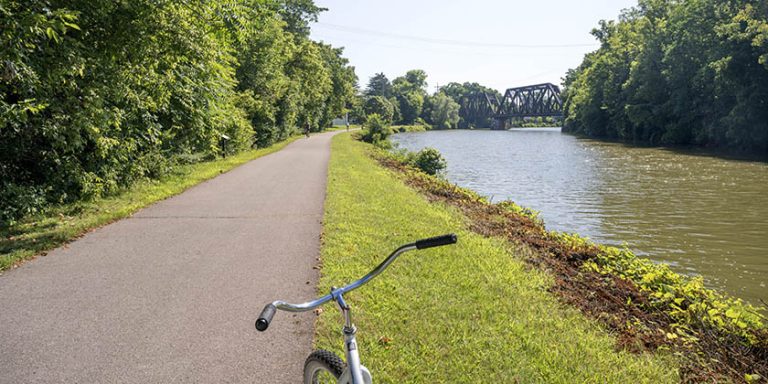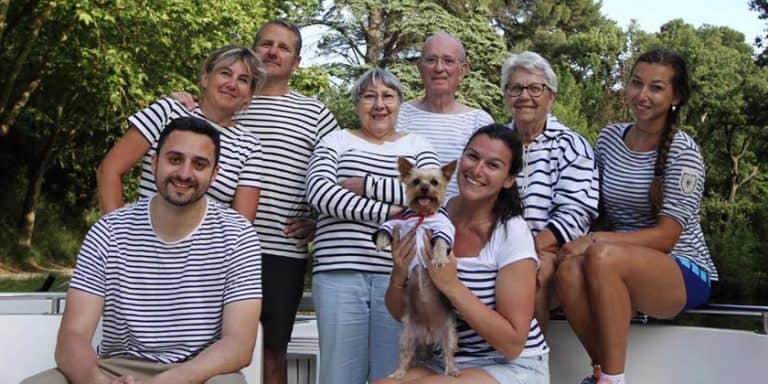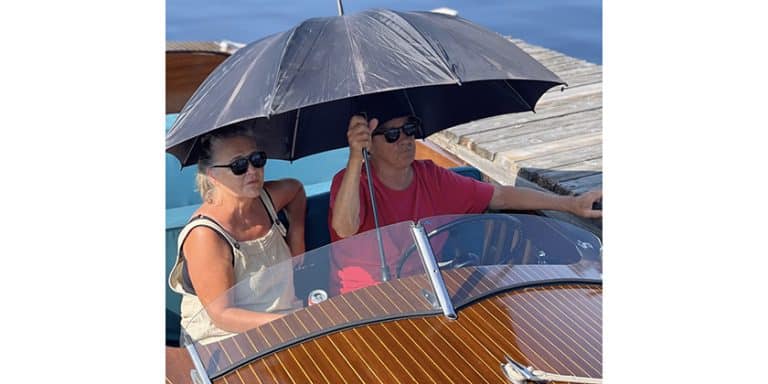Bay of Quinte and Thousand Islands – Sensational Summer Migration
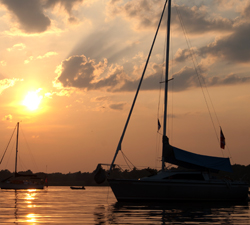
Story and Photos by David Platt
Each summer, in a Canadian cruising tradition, thousands of Western Lake Ontario sailors join the annual summer migration to the Bay of Quinte and the Thousand Islands. The route, for most of us, begins somewhere in the heavily populated environs of the Greater Toronto Area and takes us along the North shore of Lake Ontario through the protected waters of the Bay of Quinte ending in the crystalline waters of the Thousand Islands. This year, four of us decided to head east in two boats. Our companions, Alex and George, are racing sailors who take three weeks off each year to cruise in Merlin, their C&C 27. My wife Eileen and I are travelling in Solace, our well-loved Oday 240.
The fun part of this trip begins in Cobourg, a beautifully preserved Ontario port town founded in the 19th century. Constructed to ship out local resources and agricultural produce at a time when the province’s commerce depended on access to waterways, the port has outlived its commercial origins. The infrastructure has been redeployed to serve boaters and promote tourism. Boaters coming to Cobourg have several options for securing their boats. Members of reciprocal clubs can stay on the west wall as guests of the Cobourg Yacht Club for the first night. A slip can be obtained from the town marina or there is enough space to anchor in the harbour. The town marina is impeccably maintained and free coffee is usually ready by 8:00. Amenities within minutes of the marina include a gorgeous white sand beach, good restaurants, a grocery store, a marine store and a liquor store. Objections are muted when the admirals confer and decree that we are staying an extra day.
Cobourg is left behind on a rolling grey Lake Ontario day that offers little in the way of useful wind. After a twenty mile eastward slog with the motor we turn North entering Presqui’le Bay’s well marked channel. To avoid weeds and mud banks stay in the channel, which turns east to the Murray Canal, near the village of Brighton. Brighton hosts a marina and a yacht club but call ahead to check depths which can be low in late summer.
The Bay of Quinte, a protected inland waterway that is a worthy cruising destination of it’s own, stretches from the Murray Canal at it’s western end to Amherst Island on the east. The Bay separates Prince Edward County from the Ontario mainland. The most direct route through the Bay would cover about 60 linear nautical miles but the most direct route misses some of the better cruising grounds that the Bay has to offer. The Bay offers good anchorages as well as yacht clubs and marinas for those who prefer to tie up to docks.
After transiting the Murray we unroll our Gennys to take advantage of the following breeze for the short run down to CFB Trenton Yacht club. This friendly club is separated from the military base by a short causeway. Boaters are free to walk about the base and eat at the Yukon Mess where excellent and inexpensive meals can be obtained. CFB Trenton is also home to the National Air Force Museum of Canada. The club is currently dealing with an invasive type of weed that mats around keels and rudders. Both Solace and Merlin become stuck on the way to the visitor dock and require towing from the sailing school instructors with their 40 hp RIB. They appear to be disturbingly experienced at this and both boats are clear of the weeds in minutes. Call ahead on VHF channel 68 to get a definitive update on the weed situation before entering the club channel.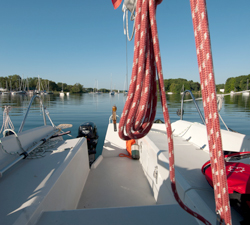
The following morning the weather is cool and rainy with thunderstorms. Departure is delayed until noon when the weather improves slightly. During the two hour sail to Belleville we admire cottages and waterfront homes with moorings which line the route. The Bay of Quinte Yacht club is full. The public wall here is a free option but with a west wind and unsettled weather forecast we obtain slips at Meyers Pier Marina.
The inclement weather comes to an end the next morning and we point our bows east. Leaving Belleville, the wind is a solid 10 knots from the northeast and, in true inland lake fashion, shifty. Having learned to sail on inland lakes, I keep a jaundiced and cynical eye on the headland at Trident point and start making distance to windward whenever the opportunity presents itself. Our more trusting compatriots in Merlin, used to the somewhat more predictable winds of Lake Ontario, aim for the point and end up putting in two short starboard tacks. We stow the sails and turn on the engines just before Telegraph Narrows. After motoring through the narrows and turning south past Foresters Island, anticipating an exciting ride down the Long reach, we throw up the asymmetrical spinnaker. Apparently the wind gods feel they have done enough for us today because we end up motoring slowly down the Long Reach between wooded shores, farmland and cottages the rest of the way to Picton.
Picton is a tiny jewel of a harbour. Completely protected on four sides by virtue of its location at the end of a long and curving bay, the harbour is about 1/2 mile long and 200 yards across. The bay is home to two yacht clubs, a marina, private docks and mooring balls. Anchoring, with good protection from most directions, is possible just outside the harbour proper. We secure spots at the Prince Edward Yacht Club, founded in 1937 and located on the North West side of Picton Harbour. This is a small club that receives a lot of visitors so they do charge a flat fee of $24.00 for the first night and offer the second night for free. Having a drink in the bar overlooking the harbour is almost guaranteed to involve you in a conversation with someone. Downtown is a 10 minute walk away although it does involve an ascent up a hill that gives a good cardio workout. Picton, which has a population of about 4,000, has not succumbed to the “Mall Disease” that has affected so many communities in North America. The downtown is still vibrant and offers shopping, excellent restaurants and entertainment.
We leave Picton heading east between Prince Edward County and the Ontario mainland. The old village of Glenora passes by to starboard, nestled on the edge of the water with its 1850’s style stone buildings and the ferry terminus for the Loyalist Parkway. Prinyers Cove, a popular anchorage about 13 miles from Picton, is about 3/4 of a mile long and 150 yards wide with a northeast facing entrance. The cove has a marina and some docks as well as permanent moorings. Wanting to be well away from the mooring field, we settle on a spot close to the entrance in 20 feet of water. The rest of the afternoon is spent lazing around on the boat, swimming in crystal clear water and exploring the cove with our inflatable kayak.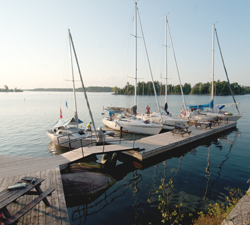
Bows are pointed eastward again from Prinyers. The plan is to end the day at Collins Bay Marina in Kingston. A university town with a population of about 150,000, it was the original capitol of Canada and is home to 3 marinas and two yacht clubs. The European presence dates back to 1673 when the French established Fort Frontenac to control access to the fur trade. When the English took control of Canada, Kingston became an important military post because of its strategic location. It was home to Fort Henry, the Kingston Royal Naval Dockyard and is the head-water of the Rideau Canal. The area was settled by thousands of United Empire Loyalists who fled The United States after the American Revolution.
We leave Collins Bay Marina under a scudding pewter sky. The South wind, usually a harbinger of bad weather on Lake Ontario, has raised five foot waves that blow into the gap between Amherst and Howe Islands and directly into the bay as we motor out. Once we are out far enough, we turn east, unroll our Genoas and sail off at five knots into the flatter water in the lee of Howe Island, the largest of the Thousand Islands. We sail past downtown Kingston with its Martello towers and the low grey walls of Royal Military College. Martello Towers, an Italian development, were built by the British Military to defend Canada against invasion by the U.S. in the 1840s. They were small round forts used as gun batteries, manned by 15 to 25 men. Their shape and construction made them difficult to breach with period artillery. Apparently they are still an effective deterrent because no invasion has occurred.
Trident Yacht Club, whose stately and gracious clubhouse overlooks the Bateau Channel, is surrounded by mature trees and is backed by a heavily wooded slope. This cruising oriented club has a kitchen, laundry facilities, screened in BBQ area and numerous spots where one can vegetate peacefully in the shade. The water at the docks is aquarium clear and early morning is the best time for observing aquatic life.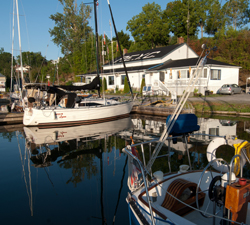
Leaving the eastern end of the Bateau channel we enter the Admiralty Group of the Thousand Islands. There is a mix of island cottages and publicly owned islands managed by Parks Canada in the group. Mermaid Island, the first of the Parks Canada sites we encounter, has a vacant dock large enough for a 24 footer and we tie up to it while Merlin’s crew elect to spend the night in Ganaoque. Dock space in the Thousand Islands is at a premium during summer especially on long weekends. There are not that many spaces to start with and the trend towards larger boats often means that fewer can fit in the existing facilities. The sky is clear and the temperature reaches 35 degrees. We spend the day getting hot and cooling off by swimming from the back of the boat and watching tour boats. When evening approaches and the temperature drops we take the inflatable kayak for a jaunt to another of the Park Islands, Beau Rivage.
The crew of Merlin likes the sound of our day on Mermaid so we wait until they arrive the next morning and surrender our spot to them while we go exploring. Heading east down the Wanderers Channel, which is privately marked but used by large tour boats, we check out anchorages east of Beau Rivage Island and west of McDonald Island for future reference. Emerging from the Wanderers Channel we can see Ganonoque, a small tourist town with a population of about 6,000, about a mile away and decide to visit. There is room at the public wharf so we tie up and go for lunch to celebrate the skipper’s birthday. For those with a cultural bent, Gananoque is home to the Thousand Islands Playhouse which offers live theatre in two venues. Docking is free if you are attending a play but reservations are required.
Leaving Ganaoque, we thread the channel between Hay and Forsythe Islands and enjoy a brisk beat up the south side of Bostwick Island. On the way we pass an island with nothing but a flagpole and a dock. These islands are purchased and used as retreats by boaters who never actually erect buildings. Rounding Mermaid Island in the late afternoon we check in with Merlin’s crew who are in no mood to move. Choosing to anchor for the night, we head back down the Wanderers Channel for the second time today. We drop the hook in a large uncrowded anchorage west of McDonald island with about 20 other boats and break out the Scotch in time to sit back to watch a glorious Thousand Islands sunset.
The weather the next day is underwhelming. There are wind warnings and small craft warnings in effect with gusts hitting 30 knots. A couple of boats leave the anchorage and we see at least one of them re-anchoring after about an hour. We hear from Merlin that there is a free dock at Mermaid but as we are well protected and feel good about the set of our Bruce anchor we decide to stay put. The chop doesn’t get over 6 inches in our anchorage so we feel comfortable swimming off the back of the boat despite the weather.
We up anchor the next morning, motor up the Wanderers channel for the last time and rendezvous with Merlin. The time has come to point our bows west again. By the time we get back to the Murray Canal we will have spent almost 2 weeks meandering through the protected waters of the Bay of Quinte and the Thousand Islands and have seen only a small part of these fabulous cruising areas. Will we be joining the annual migration again? We will.
Photo Captions:
Photo 1 – Solace anchored at sunset in the Thousands Islands.
Photo 2 – Merlin, a C&C 27, reaches past a martello tower at Kingston.
Photo 3 – Prinyer’s Cove from Solace’s cockpit.
Photo 4 – The Parks Canada Dock at Mermaid Island.
Photo 5 – Prince Edward Yacht Club.

